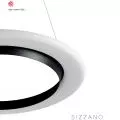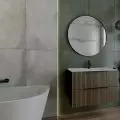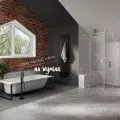An interesting residential interior has been created from a former well-known local carpentry shop. Polish architects - Eliza Borkowska and Magdalena Czapluk of KEMA Studio, living and designing on a daily basis in Portugal, faced a formidable task - how to preserve the identity of the post-industrial interior and give it a modern look and feel. The result surprises, it is stylish, elegant and functional.
The presented project was carried out in Lisbon, the capital of Portugal, in a district where industry mixes with residential buildings, creating a very dense urban fabric. The site had served as a local carpentry workshop for many years prior to the renovation. Located on the basement floor of a residential building, it was characterized by very limited access to daylight.
diagram of the changes made
pic: KEMA studio
how do two simple cubbies organize the space?
Already after the first visit, we realized that the place was unique and that there was great potential. From that moment on, the goal of our project became to preserve and enhance the uniqueness and authenticity of the existing space and complement it in such a way as to give it a special atmosphere and personality. The existing condition remained unchanged with the exception of the rear facade, which was opened up to let as much natural daylight into the space as possible, while strengthening the relationship between inside and outside. This carpentry workshop, due to its function, had an open plan. Our introduction of two simple cubbies separated the functions needed for the proper functioning of the apartment. A black cubicle, made of stained wood fiber panels, separated the technical zone with a storage room. The cork cubicle, finished with warm, acoustic cork panels, separated the apartment's private zone - a bedroom connected directly to an outdoor patio. Both cubbies were made of sustainable, ecological and local materials.
View from the kitchen to the living room
Photo: João Morgado
how to combine the old with the new?
We wanted the choice of materials to emphasize the character of the interior. We decided to preserve elements of the existing space, valuable for their authenticity, such as the massive brick arches and the steel structure with concrete pillars supporting it. Introducing new elements, we played with the contrast of color, temperature and sound. In this way, we managed to create a space with a homely atmosphere, while preserving the "industrial" identity of the place, combining black, cold, sonorous steel with bright, warm and calming cork. Given that the place was a well-known local carpentry shop, we decided to use the wood left over from the workshop and bring it back to life in a modern way. We used it to make a handmade kitchen island top, with a pattern we designed, created from two types of glued wood, protected with oil. We also used it to create bedside tables and to finish one of the walls of the patio, creating a composition in "pixels," made from more than 14 different types of wood from around the world. We also restored an old piece of furniture found in the workshop to present it in a new look as an under-sink piece.
The view from the kitchen to the bathroom
photo: João Morgado
kitchen with an arch
As a rule, the kitchen is the heart of any home. It was no different in our project. Located under a majestic arch, right in the center of the living room, it catches the eye with its contemporary arrangement of materials. Much attention is drawn to the marble countertop with an additional auxiliary shelf with a "tiger skin" pattern, the dark cabinets made of polished black Valchromat panels and the gold-colored lamp, which harmonizes with the cork floor in the living room. The black and white patterned floor, made of ceramic tiles, adds character to the interior and separates all the wet rooms, by continuing the floor from the kitchen to the bathroom, wrapping around to the wall with a bathroom mirror. The walls, made of stone with brick arches, have been protected and painted white to enrich the design of this bright, modern interior with their texture.
patio in the evening
Photo credit: Marco Pezzutto
entrance and exit
The entrance area was separated from the living room by means of translucent panels made of expanded metal. In this way it was possible to separate the functions without disturbing the impression of openness of the space, so characteristic of post-industrial places. The outdoor patio, on the other hand, has undergone a complete metamorphosis. A multifunctional space was created with a continuous bench and a pot for climbing maracas, providing the opportunity to relax both during the day and at night under ambient light.
As a result, we were able to create a well-defined space commemorating what it once was. A comfortable space, filled with morning light from the entrance area and flooded with afternoon sunlight streaming in from the patio.






































































